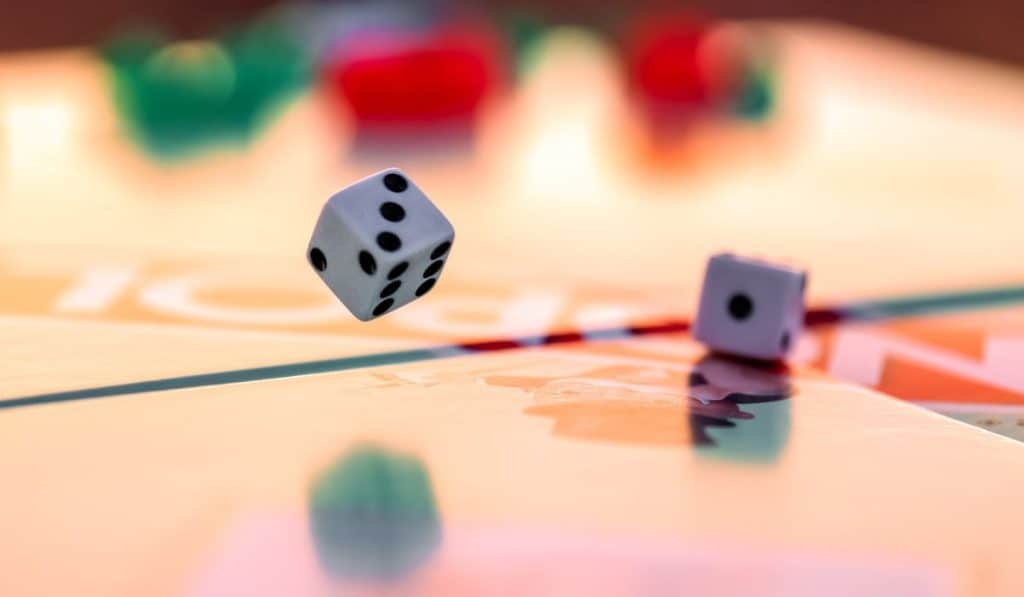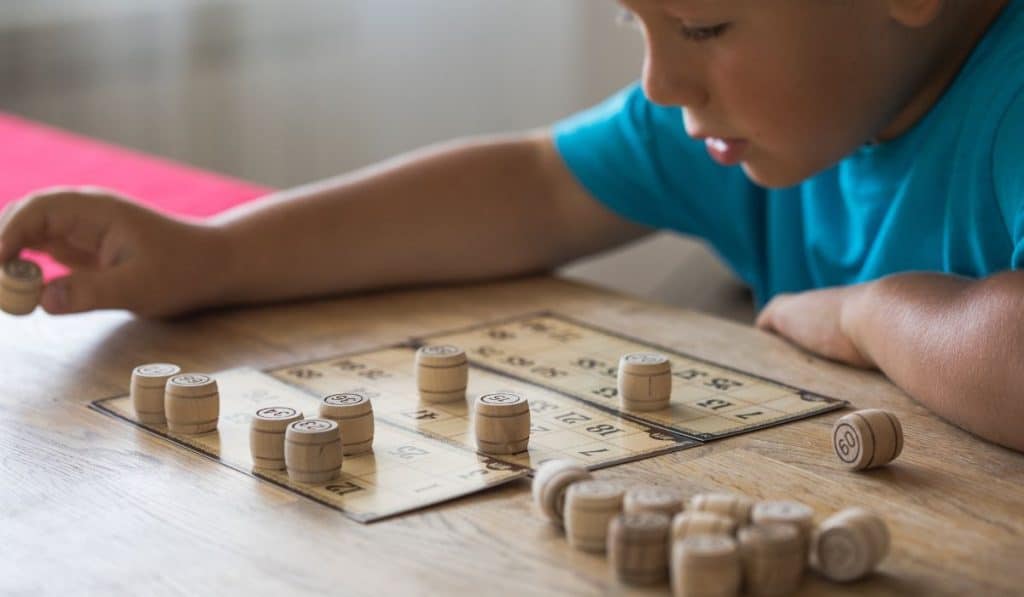Mathematical problems can be a source of stress for most students.
What if we told you that there is an array of easy math games that can make math a little less intimidating for youngsters?
Whether you are a parent looking for ways to make math practice fun at home, or a teacher looking to make your lessons more enjoyable, this roundup of easy math games will come in handy.

Easy Math Games for Classrooms
Odds and Evens
Grades: K to 2nd
Age range: 5 to 7 years
You can never go wrong with a classic math game.
Odds and Evens is perfect for a classroom setting — it requires only a pen and piece of paper per player, which are readily available in a classroom.
How to Play
Have each player or student create two columns on their piece of paper by drawing a line in the middle. The right-side column is for even numbers while the left side one is for odd numbers.
Next, with the players taking turns, have them roll a die and record the corresponding number in its respective column. The first person to get 10 points in any column is the winner.
Through this game, your students will learn how to identify even and odd numbers.
Buzz
Grades: Kindergarten and above
Age range: 5 years and above
You will love this game if you are looking for an easy math game that can engage an entire class all at the same time. Or one to sharpen your students’ counting skills, addition, and multiplication.
How to Play
Divide your students into groups of at least four players each and have them all sit down in a circle.
Next, instruct them to take turns counting from 1 until they get to 7 or a multiple of 7 where the players, in turn, must say ‘buzz’.
Any player who doesn’t say ‘buzz’ or says it in the wrong place is out of the game. The winner in this game will be the last player standing.
You can also go with other numbers like 10, 5, 9, 6, or any other to make it a more comprehensive game.

Around the Block
Grade: 3rd to 5th
Age range: 8 to 10 years
This is yet another game that you can have your students playing concurrently, in which case you will need several balls.
How to Play
With students standing in a circle, instruct the first player to roll the ball over to another player of their choice in the circle — alternatively, the first player can randomly roll over the ball.
Afterward, instruct the player catching the ball to identify the math operation he or she will use to solve a math problem posed by whoever rolled the ball.
After solving the problem they should call out the answer, after which they can continue rolling the ball to other players if their answer is right, or leave the game if their answer is wrong.
This goes on until only one student is left standing.
Around the Block is a perfect way for students to sharpen their skills in various math operations.
Twenty-One
Grade: 3rd to 5th
Age range: 8 to 10 years
You can easily play this game with a regular card deck so long as you remove the aces and face cards before shuffling the deck.
How to Play
Once each player has a marker pen and a whiteboard, deal out two face-down cards to each player. One after another, the players will flip over their topmost card and reveal its number to their classmates.
The aim is to get closest to the number ‘21’ without going over. To avoid going over ‘21’ after flipping their next card, a player can choose to keep their first score.
Any student who goes over 21, therefore, is out of the game.
A variation of this game entails using three or more cards instead of two.

Graph Scavenger hunt
Grade: K to 2nd
Age range: 5 to 7 years
You will love making graphs a little more exciting for your students with the graph scavenger hunt game.
How to Play
To start this game, draw a graph that features various items to be treasure hunted around the school or classroom.
Next, have your students walk around finding things that match the items featured in the graph.
For instance, a bar graph can be a great idea for your students to find things of specific colors.
Picture graphs, on the other hand, can have the students hunting for things that look a certain way — could be big or small.
They should then color or mark the graph for each thing they have found and share their findings with the rest of the class.
Number Dance
Grade: Pre-K to Grade 1
Age range: 3 to 6 years
The Number Dance is a great way to practice numbers that also doubles as a clever way to get your students moving to avoid boredom.
It will especially come in handy when you notice their concentration starting to wane and is also helpful for gross motor skills. Luckily, all you need is ample room and music.
How to Play
Start by setting up a number mat. You can easily do this by taping or velcroing number placards to the floor — numbers 1 to 20 will do.
Once the setup is done, instruct your students to start the game by standing on a random number.
Start the music and have them dance around except for whenever the music stops, where they are supposed to stand on a new number.
You can add some variations to make the game more interesting.
For instance, you can ask the students to spin around whenever they land on a multiple of 3, stand on one foot if the number is even or squat if the number is odd, and so on.

Easy Math Games to Play at Home
Multiplication Bingo
Grade: 3rd
Age range: 5 and above
Did you know that you can add a mathematical twist to the classic Bingo? Now you do and it is a fun way to sharpen your kids’ multiplication skills.
How to Play
The game starts with the kids writing down 5 multiples of their chosen times table. For example, if they have chosen the 3 times table, expect them to write numbers 6, 9, 12, 15, and 18.
Next, have another kid lead the game by calling out questions from the chosen multiplication table.
Alternatively, the questions can be written on paper or cards and piled up for the players to pick and read out in turns.
As this happens, the remaining players should cross out any correct answers on their boards. The first player to cross all their chosen numbers wins the game.
Maths Fact Race
Grade: 2nd to 5th
Age range: 7 to 11 years
The Maths Fact Race is a superb way to keep a group of schoolgoers entertained during a playdate or a birthday party.
How to Play
Simply divide the youngsters into teams and have them stand on one far end of the chosen race area. You do not have to team them up if there are not as many.
Next, prop a grid sheet on the other end of the racetrack. You will need to prop more than one grid sheet if you have several teams as each team needs one.
Once set, give the youngsters marker pens and have them take turns running to the grid sheet and filling in the correct answers for the various problems.
The answers are determined by the math problems the grid requires them to solve.
For instance, for multiplication practice, a player will have to write 18 where the sixth column and third row meet.
Afterward, the player returns to their team allowing another team member to run and fill another grid space.
Alternatively, the next player can run and correct a previously wrong answer. This goes on until a team has correctly filled their entire sheet.

One-Yard Dash
Grade: 3rd to 5th
Age range: 8 to 11 years
The One-Yard Dash game avails the perfect opportunity for you to sharpen your child’s grasp of measurements from the comfort of your home.
The best part about this easy math game is that it makes sense to one child as it would do many, and is, therefore, not limiting.
Give your child or children a yardstick and ask them to look around the house and make a record of at least five items they think are a yard long.
Next, go through their findings with them to see how close they came without going over.
In the case of different teams, the team with the closest estimated items will be the winner.
To make the game more challenging for advanced school-goers, you can ask them to convert their findings into centimeters, inches, or millimeters.
Final Thoughts
Practice makes perfect and what better way to train your child’s or students’ brains than with these fun and easy math games?
The upside is that these games are extremely effective and require little to no preparation and resources.
Don’t let the recommended grade level and age range limit you.
These games can be used on students who need mathematical assistance even if they are past the recommended age and grade.
Resources:
- https://www.weareteachers.com/active-math-games/
- https://lauracandler.com/5-math-games-every-classroom-needs/
- https://www.splashlearn.com/blog/best-classroom-math-games-for-kids/
- https://thirdspacelearning.com/blog/fun-maths-games-activities-for-kids/
- https://www.prodigygame.com/main-en/blog/classroom-math-games-for-kids/




